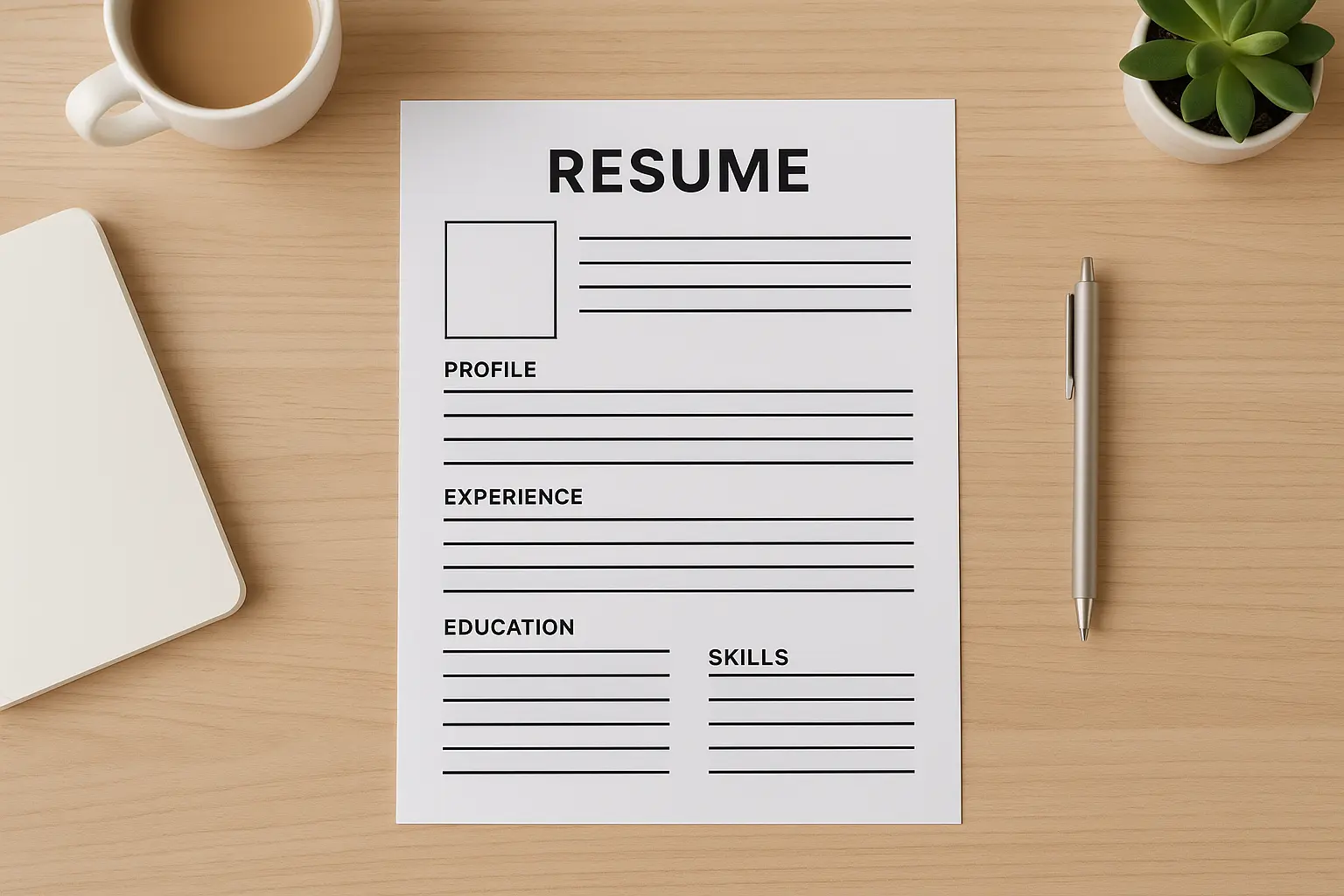Stop Overthinking Your Resume: How Many Jobs Should You Actually Include?

Let’s cut through the BS. You’re staring at your resume wondering if you should include that job from 2018, and you’ve probably Googled this question twelve times already.
Here’s the truth nobody wants to tell you: there’s no magic number. But there are some smart guidelines that actually work in the real world.
After looking at thousands of resumes (and seeing what gets people hired), here’s what I’ve learned about picking the right jobs for your resume.
The Real Answer
Most people should include 4-6 jobs, but here’s what actually matters:
-
Your experience level trumps everything else
-
Industry expectations vary wildly
-
Recent and relevant beats comprehensive every time
-
Quality achievements matter more than quantity of positions
Recent analysis of over 93,000 resumes reveals that job seekers in the U.S. list an average of 9.65 skills, with most falling between 6 and 20 skills, according to American Workforce Group research. This data underscores the importance of strategic content selection – not just for skills, but for job positions as well.
Understanding the fundamentals of resume length strategy becomes crucial when determining optimal job count, as your overall document structure directly impacts how many positions you can effectively showcase.
Your resume length directly impacts how hiring managers perceive your experience level, career progression, and fit for the role. The number of jobs you include sends signals about your stability, growth trajectory, and professional focus. This isn’t about following arbitrary rules – it’s about making strategic choices that position you as the ideal candidate while respecting the limited attention span of busy recruiters who spend mere seconds scanning each resume.
Your Experience Level Changes Everything
Your professional experience level fundamentally shapes how many positions belong on your resume. The key is matching your job count to hiring manager expectations for your career level while showcasing relevant growth and achievements.
Just Starting Out?
You’re probably panicking about having “enough” stuff to put on your resume. Stop.
2-4 positions is perfect when you’re new. This includes internships, part-time work, even solid volunteer gigs. I’ve seen new grads try to cram in every job they’ve ever had, including that two-week retail stint. Don’t do this.
When crafting your first professional resume, understanding how to build a resume with no experience helps you strategically select which positions deserve space, even with limited work history.
Instead, ask yourself: “What shows I can do the job I want?” Your marketing internship? Definitely. That restaurant job where you trained new staff? Shows leadership. Your high school grocery store gig? Probably skip it unless you’re really short on experience.
Taylor, a recent graduate with no full-time experience, strategically included: Marketing Intern at BrightStart Agency (Jan–May 2025), Temp Social Media Assistant at LocalBiz Co. (Aug–Dec 2024), and Academic Projects where they developed go-to-market strategy and campaign mockups for a case competition. Taylor excluded campus jobs and unrelated summer work to keep the resume focused on marketing skills.
Focus on positions that demonstrate:
-
Transferable skills relevant to your target industry
-
Leadership experience (even if it was leading a group project)
-
Problem-solving abilities
-
Work ethic and reliability
Been Working for a While?
You’ve got options now – maybe too many. This is where people get stuck.
With Bureau of Labor Statistics data showing that most workers stick with a job for roughly 4.1 years, according to Teal’s research, most professionals will have several roles within a 10-15 year span, making strategic selection even more critical.
Aim for 4-6 positions that tell a story of growth. You want to show you’re getting better at what you do, taking on more responsibility, and delivering results.
That job from 12 years ago doing the same thing you do now? It’s probably not adding much. But if it shows a key skill or major win that’s relevant to where you’re headed, keep it.
Focus on roles that demonstrate:
-
Increasing levels of responsibility
-
Skill development that’s relevant to where you want to go next
-
Quantifiable achievements and results
-
Industry expertise or cross-functional experience
Senior-Level Professionals: Strategic Impact Over Everything
At the executive level, your resume isn’t just about what you’ve done – it’s about the impact you’ve made and the value you can bring to an organization.
Senior professionals should typically include 5-8 positions, but here’s the catch: they should all demonstrate leadership, strategic thinking, and measurable business impact. Your early career positions? They can probably be consolidated into an “Early Career” section or omitted entirely.
What matters at this level:
-
P&L responsibility and business results
-
Team leadership and organizational development
-
Strategic initiatives and transformation projects
-
Industry recognition and thought leadership
-
Board positions or advisory roles
Michael, a senior engineer with 18 years of experience, strategically combined his intern and associate roles at the same company to show progression while saving space. His resume included: Senior Software Engineer at BigTech (2020-Present), Software Engineer at MidSize Corp (2016-2020), Junior Developer at StartupDEF (2012-2016), and a consolidated “Software Developer Intern → Associate Developer at TechGiant (2007-2012)” entry.
Industry Expectations (Because They’re All Different)
Different industries have distinct expectations for resume length and job history depth. Understanding these industry-specific norms helps candidates align their resume strategy with hiring manager expectations and cultural fit requirements.
Traditional Corporate Jobs
Finance, consulting, law – these folks want to see everything. They expect 6-8 positions for experienced people and get nervous about gaps. They want to see steady progression and proven stability.
Be straightforward here. No creative formatting tricks. Show clear advancement in titles and responsibilities.
These industries also tend to be more concerned about employment gaps. If you took time off or had a short stint somewhere, you’ll need to address it. The conservative nature of these fields means they value predictability and proven track records.
Each position should clearly show:
-
Progression in title and responsibility
-
Relevant certifications or credentials
-
Client or project experience
-
Quantifiable business impact
Tech and Creative Fields
These industries care more about what you can do right now than where you’ve been forever.
Recent industry insights emphasize the importance of technical skill specificity on resumes. As “Dice career advice” notes, instead of merely stating ‘Python,’ professionals should say ‘leveraged Python to develop a hotel recommendation algorithm that increased bookings by 20 percent,’ showcasing both technical skill and measurable impact.
4-6 recent, relevant positions usually tell the story better than a complete work history. These fields understand that careers can be non-traditional, and they’re more interested in your ability to contribute immediately than your long-term organizational loyalty.
Don’t stress about having a perfectly linear career path. These fields get that careers can be all over the place.
The focus should be on:
-
Technologies you’ve worked with
-
Projects you’ve completed
-
Results you’ve achieved
-
Skills that are current and in-demand
Freelance work? Contract gigs? Project-based stuff? All good – just label them clearly.
Format Choices That Actually Matter
Resume format significantly impacts how many jobs you can effectively present. Your choice between different resume format options directly influences how many jobs you can showcase effectively, with each format offering unique advantages for different career situations.
Standard Chronological Resume
This is what most people expect to see. Research shows that 75% of hiring managers prefer the reverse-chronological resume format, according to Teal’s industry analysis, making this format choice critical for job seekers who want to align with recruiter preferences.
You can fit 4-6 jobs comfortably if you’re smart about space:
-
Your current job: 4-5 bullet points with real achievements
-
Previous job: 3-4 bullets focusing on key wins
-
Older positions: 1-2 bullets or just basic info
This format requires you to be ruthless about editing. Every bullet point needs to earn its place, and you’ll need to make tough decisions about which positions deserve the most real estate.
The advantage? Hiring managers can quickly see your career progression and understand the timeline of your experience. The disadvantage? You might have to leave out some positions that could be relevant.
Need More Flexibility?
If your career path isn’t perfectly neat, consider a functional format. You can list 6-10 positions briefly while dedicating most space to skills.
Some hiring managers aren’t fans of this format, but it works well if you’re changing careers or have gaps to work around.
This works particularly well if you:
-
Are changing careers and need to highlight transferable skills
-
Have employment gaps you want to de-emphasize
-
Have diverse experience across multiple industries
-
Are returning to work after time away
Just make sure your skills sections are well-organized and directly relevant to your target role. The employment history section should still include company names, job titles, and dates – just without the detailed bullet points.
The Art of Picking Winners (And Ditching Losers)
Look, I get it. Every job feels important because you lived it. But your resume isn’t your autobiography – it’s your highlight reel.
Here’s how to be ruthless about what stays and what goes:
The Quick Test
For each job, ask yourself:
-
Does this show skills I need for my target role?
-
Can I point to at least one solid win from this position?
-
Is it recent enough to matter (usually past 10-15 years)?
-
Does it make my overall story stronger?
If you’re answering “no” to most of these, that job probably doesn’t belong on your resume.
Here’s a framework I use to help people decide which jobs make the cut. Create a simple scoring system for each position based on these factors:
Skill Overlap with Target Job (40% weight): How closely do the skills you used match what you’re applying for?
Industry Relevance (30% weight): Is it in the same industry or a closely related field?
Level of Responsibility (20% weight): Did you have significant responsibilities or achievements?
Recency (10% weight): How recent is the experience?
Score each factor from 1-10, then calculate a weighted average. Positions scoring 7+ should definitely be included with full details. Scores of 5-6 might get abbreviated coverage. Anything below 5 should be seriously considered for omission.
This takes the emotion out of the decision. You might love that job you had five years ago, but if it’s not relevant to where you’re going, it might not deserve space on your resume.
When Older Jobs Still Matter
Sometimes a position from way back deserves a spot because of one killer achievement. Like leading a team that saved the company $2M or launching a product that’s still successful today.
That’s smart strategy. Just don’t include old jobs because you’re nostalgic about them.
When evaluating achievements, look for:
-
Quantifiable results (increased sales by X%, reduced costs by $Y)
-
Leadership or management experience
-
Problem-solving examples with clear outcomes
-
Recognition or awards received
-
Skills developed that are rare or valuable
A position where you can say “Led a team of 12 to deliver a $2M project 3 months ahead of schedule” is worth including, even if it was 8 years ago and in a slightly different industry.
Making Every Word Count
You can’t treat every job equally or your resume becomes a novel. Use this approach:
Most Recent Job: Give it the royal treatment – 4-5 bullets with specific numbers and impact
Second Most Recent: 3-4 bullets focusing on your biggest wins
Everything Else: Keep it brief – 1-2 bullets or just the basics
This matches how people actually read resumes. They spend the most time on your current role anyway.
What to Leave Out Entirely
Consider leaving out positions that:
-
Are more than 15-20 years old (unless they show critical skills or achievements)
-
Are completely unrelated to your career goals with no transferable skills
-
Lasted less than 6 months without significant accomplishments
-
Are redundant with other experience you’re already showing
Modern
Modern recruitment practices are becoming increasingly selective about what candidates include on their resumes. As career advisor Stacie Haller from Resume Builder notes in “recent industry guidance”, recruiters avoid anything that feels outdated, emphasizing the importance of strategic omissions to maintain a current, relevant professional image.
But here’s the key: don’t create weird gaps in your timeline. If cutting a job leaves a mysterious year-long hole, you might need to include it with minimal detail just to keep things flowing.
Sometimes you can solve this by adjusting date formats. Instead of listing specific months, use years only. “2019-2021” covers a lot of ground and doesn’t highlight short-term positions or brief gaps.
What’s Changed (And What Hasn’t)
Contemporary resume considerations include ATS optimization requirements and digital portfolio integration. Understanding ATS-friendly resume formatting becomes essential when deciding how many positions to include, as proper formatting ensures all your carefully selected jobs get properly parsed by applicant tracking systems.
ATS Systems Are Real
Most resumes get scanned by software before humans see them. The good news? These systems don’t care if you list 4 jobs or 8 jobs. They care about finding keywords and reading your formatting correctly.
Make sure each position includes 2-3 relevant keywords from the job posting, but weave them in naturally. And keep your formatting simple – standard bullet points, consistent dates, clear job titles.
More importantly, maintain consistent formatting across all job entries:
-
Same date format throughout (MM/YYYY works best)
-
Clear job titles and company names
-
Consistent location formatting
-
Standard bullet points (avoid fancy symbols or graphics)
This means you might include a position primarily because it contains important keywords, even if it’s not your most impressive role. Strategic? Absolutely.
Your LinkedIn Changes the Game
Your resume doesn’t live alone anymore. Hiring managers will check LinkedIn, so make sure they match up.
Think of LinkedIn as your complete story and your resume as the best parts. They should align but don’t need to be identical.
Your LinkedIn profile can include more positions than your resume because space isn’t as limited. But the jobs you do include on your resume should align with what’s on LinkedIn, using similar descriptions and keywords.
This actually works in your favor – you can be pickier with your resume because interested employers can find more details online if they want them.
For creative and technical roles, consider whether you have portfolio pieces or work samples that support each position you list. If you can’t demonstrate the work you claim to have done, that position might not be worth the space.
Your Game Plan
Practical implementation requires applying the 10-15 year rule strategically while managing employment gaps and consolidating related experiences.
The 10-15 Year Rule (With Smart Exceptions)
Start with jobs from the past 10-15 years. This keeps things current and manageable.
Most career experts throw around the “10-15 year rule” without context. Here’s the truth: it’s a good starting point, but not a hard rule.
Break this rule when older positions:
-
Show certifications or licenses that are still current and relevant
-
Demonstrate specialized skills that are rare in your field
-
Include major achievements or recognition that support your current goals
-
Show early experience in your target industry that adds credibility
The key is being intentional about exceptions. Don’t include that 18-year-old position just because you loved the job. Include it because it adds something valuable to your current professional narrative.
Sarah, a marketing professional with 8 years of experience, included three positions: Marketing Manager at TechCorp (2022-Present), Marketing Specialist at StartupXYZ (2019-2022), and Marketing Coordinator at AgencyABC (2017-2019). She strategically excluded her college retail job and a brief two-month contract role that ended due to budget cuts, maintaining focus on relevant marketing progression.
Handling Employment Gaps
Gaps happen. Don’t try to hide them – handle them strategically.
Fill gaps with relevant stuff when you can:
-
Consulting or freelance work (even small projects)
-
Volunteer work that used professional skills
-
Professional development or education
-
Family responsibilities (if you’re comfortable sharing)
Format these consistently with your paid positions but label them clearly. “Marketing Consultant (Various Clients)” or “Professional Development & Family Responsibilities” work fine.
You can also smooth things over by using year-only dates instead of month/year, or combining short-term contracts into one entry.
You can also use consolidation techniques to smooth over gaps:
-
Combine multiple short-term contracts into one entry
-
Group similar roles at the same company under one heading
-
Use year-only dates instead of month/year to minimize small gaps
The goal isn’t to deceive anyone – it’s to present your experience in the most professional and coherent way possible.
For professionals with non-traditional career paths, learning how to show promotions on a resume can help consolidate multiple roles at the same company into compelling career progression narratives.
Resume Builder IQ’s AI-powered platform takes the guesswork out of these complex decisions by analyzing your complete work history and automatically recommending which positions to include based on your target role and industry standards. The intelligent system helps you handle gaps strategically, suggests optimal job counts for your career level, and ensures ATS-friendly formatting regardless of how many positions you include. With built-in expertise guiding every decision, you can create a strategically optimized resume that showcases your best 4-6 positions while maintaining professional credibility – helping users achieve 38% more interviews and 23% higher job offer rates.
Bottom Line
There’s no magic number of jobs for your resume because your situation is unique. The key is making every position count toward getting you where you want to go.
Whether that’s 3 jobs or 8 jobs doesn’t matter as much as making sure each one serves a purpose in your story. Focus on what’s relevant, recent, and results-driven rather than following arbitrary rules.
The question of how many jobs to list on your resume doesn’t have a one-size-fits-all answer, and that’s actually good news. It means you have the flexibility to make strategic choices based on your unique situation, career goals, and industry expectations.
Take some time to honestly evaluate each position. Be strategic about what you include and what you cut. Your resume should make it crystal clear why you’re the right person for the job – and sometimes that means leaving out perfectly good experience that just doesn’t fit the narrative.
Remember that your resume is a marketing document, not a comprehensive autobiography. Every position you include should serve a purpose in telling your professional story and positioning you for your next role. Whether that’s 3 positions or 8 positions depends entirely on your circumstances and strategy.
The most successful resumes I’ve seen aren’t necessarily the ones with the most jobs listed – they’re the ones where every single entry contributes something valuable to the candidate’s narrative. Focus on relevance, impact, and strategic positioning rather than arbitrary rules about resume length or job count.
The best resumes aren’t the ones with the most jobs listed. They’re the ones where every single entry makes the reader think, “This person gets it, and they can help us.”
As you finalize your job selections, remember that updating your resume strategically involves regular review and refinement of which positions best support your evolving career goals and target opportunities.










